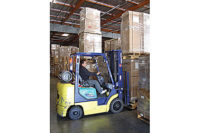Eye on Safety | Taylor Albano
Ensuring safety in crane and hoist operations: A crucial guide
Understanding the four OSHA regulations and how they impact hoist safety.

Image Source: Sunan Wongsa-nga / iStock / Getty Images Plus via Getty Images
In industries ranging from construction to manufacturing, cranes and hoists are indispensable for lifting and transporting heavy materials. However, their use carries inherent risks that can lead to serious accidents if safety protocols are not meticulously followed. To mitigate these risks, adhering to the Occupational Safety and Health Administration (OSHA) guidelines is paramount.
Incident rates
Injury and fatality rates from crane and hoist operations remain a significant concern in industries that utilize this heavy machinery. According to OSHA, cranes are involved in numerous fatal and non-fatal incidents each year, with common causes including equipment failure, improper use, and inadequate training.
The Bureau of Labor Statistics (BLS) reports that between 2011 and 2020, an average of 44 workers died annually in crane-related incidents. These fatalities often result from being struck by objects, electrocutions, and falls. Additionally, thousands of injuries are reported each year, leading to substantial economic and personal costs. These statistics underscore the critical need for stringent safety measures, comprehensive training, and adherence to regulatory guidelines to prevent such tragic outcomes.
Understanding OSHA's role
OSHA, a regulatory body within the U.S. Department of Labor, is responsible for ensuring safe and healthy working conditions by setting and enforcing standards.
For cranes and hoists, OSHA’s regulations are outlined under several sections, including General Industry (29 CFR 1910) and Construction (29 CFR 1926). These regulations cover a broad range of safety practices, from equipment inspection to operator training.
Key OSHA Guidelines for Crane and Hoist Safety
1. Regular Inspections and Maintenance:
- Frequent and Periodic Inspections: OSHA mandates that cranes and hoists undergo frequent inspections (daily to monthly) and periodic inspections (one to twelve months) depending on their usage. Inspections should focus on critical components such as hoisting ropes, hooks, and chains.
- Maintenance: Any identified issues must be addressed immediately to prevent equipment failure. Regular maintenance ensures that all components function correctly and safely.
2. Proper Training and Certification:
- Operator Qualifications: OSHA requires crane operators to be certified by an accredited testing organization or qualified through an employer's audited program. This certification ensures that operators understand the equipment, its limitations, and the necessary safety protocols.
- Ongoing Training: Continuous education and training are essential. OSHA emphasizes the need for operators to stay updated on the latest safety practices and technological advancements.
3. Safe Operation Practices:
- Load Handling: Operators must be aware of the weight limits of the crane or hoist and ensure that loads do not exceed these limits. Overloading can lead to equipment failure and catastrophic accidents.
- Clear Communication: Effective communication among the crane operator, signal person, and ground crew is crucial. OSHA guidelines recommend standardized hand signals and, when necessary, radio communication to ensure everyone is aware of the movements and load conditions.
4. Worksite Safety Measures:
- Environmental Conditions: Adverse weather conditions, such as high winds or lightning, can affect crane operations. OSHA advises suspending operations during unsafe weather to prevent accidents.
- Work Area Control: The area around the crane should be secured to prevent unauthorized personnel from entering. Barricades and warning signs are effective measures to maintain a safe perimeter.
The importance of compliance
Compliance with OSHA guidelines is not merely a legal obligation but a moral one. Ensuring the safety of workers should be the top priority for any organization. Non-compliance can lead to severe consequences, including hefty fines, legal action, and, most importantly, the loss of life.
Conclusion
Crane and hoist safety is a complex but crucial aspect of workplace safety. By rigorously adhering to OSHA guidelines, employers can create a safer working environment, significantly reducing the risk of accidents and ensuring the well-being of their workforce. In an industry where precision and safety go hand in hand, following these guidelines is the cornerstone of responsible operations.
For more detailed information on OSHA's crane and hoist safety regulations, you can visit the OSHA website or consult the specific sections of the Code of Federal Regulations (CFR).
Looking for a reprint of this article?
From high-res PDFs to custom plaques, order your copy today!






